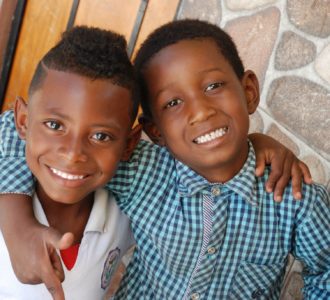Every day of the week I work at the local school, with kids from grades 2 to 7. You might think that teaching kids of that age group is somewhere between challenging and rewarding. But that couldn’t be further away from the truth, because it has been close to an impossible job. The kids just won’t listen, won’t sit down, and won’t do the work. I’m alone with them in the classroom for about an hour and a half every day, and I’m spending more time making sure they won’t fight amongst themselves with any objects they can put their hands on or leave the classroom screaming than I am actually teaching. The other teachers are facing a similar situation on a daily basis as well. The whole school staff, with the exception of two, are mestizo (which means that they are of mixed origin, white and indigenous). This fact doesn’t just prevent students from identifying with a member of the school staff, but also leads some teacher to make this racist assumption: Negritos, as the people from my home community are being referred to, aren’t capable of learning. End of the story.
Why am I telling you all this? Certainly not to reinforce this ideology that Afroecuadorians are misbehaved individuals that can’t learn, or to demonize my coworkers. Neither is it for anybody to pity me. Why is it then that I am writing this crude blog post about a part of my volunteer work here?
Because at the end of the day, maybe the staff or the kids didn’t learn anything, since it’s been going on for years, but I did: I don’t think that my students don’t possess the desire or capacity to learn, but instead I’m wondering about whether or not the format of education they receive suits their needs.
And this is what I want to write about today: Education. Why should we even question it? A lot of us are used to a certain structure of education, which takes the form of a large group of students sitting in a classroom, all of them facing a single teacher dictating the subject of the hour. Kids aren’t allowed to speak amongst themselves and should only answer questions when asked by the teacher, if there is any. But of course, as I said earlier, chaos breaks loose and the orderly classroom becomes a jungles where teaching principles vanish to be replaced by disciplinary measures.
As a lone non-native Spanish speaker and self-improvised teacher, things are a bit frightening, especially the physicality necessary to calm the kids. It has a traceable origin: the family problems my home community has, with kids growing up without a father, a mother, or without both. Things are very physical at home as well, as kids grow up surrounded by violence and being yelled at, which explains why at school a similar approach is being used, needs to be used as some say, and results in an unsettling environment. However, there are exceptions, of which my family is part of, where children grow without violence and in a caring family setting, but of course this is the exception.
An element to absolutely take into account as well is that these kids have A LOT of energy. They absolutely love to play football and they’re so good at it! No wonder so many of them want to be professional players, and actually succeed in doing so. They’re always smiling and joking around with each other. However, very little time is spent on playing outside to spend that beautiful energy, which results in uncontrollable eruptions during class time.
All of these factors combined give the environment that I witness every day, where students can’t learn and don’t want to. The result for my community is frightening: some of the students start giving up school as soon as 3rd grade and very few make it to university. How do you instill change to make these kids learn, but more importantly give them the desire to learn, for them to better their own situation and that of their families? Of course, the first primordial step for change is to work within the community to provide a healthy environment for growth, one without violence; teaching parents how to take care of their children for example. However, there is a change that also needs to happen within the school system.
One that requires involving the personality traits of the people of this region. Make them move. Make it interactive, Make it interesting. Teach them about their roots, about their own culture. Bring in teachers from their own ethnicity. Not beat them, laugh with them instead (I found out it was incredibly more efficient than the other method). And most of all: do NOT give up on them, thinking that they just can’t.
I love these kids. I truly do. They’re full of ideas, excitement, ideas, laughs and smiles. They inspire me on an everyday basis. Oh, and by the way the kids in the picture are Isaac and Jon Paul, my host cousin and my host brother, and they’re my greatest bros here in Juncal. It’s for them that I’m writing this blog post; for them to have a future, a bright one, one that doesn’t include struggling just to be there in class.

